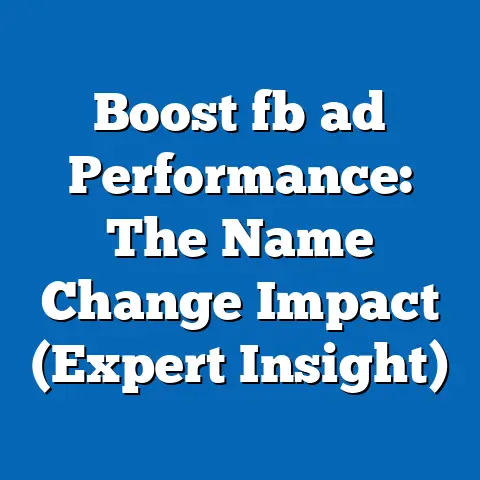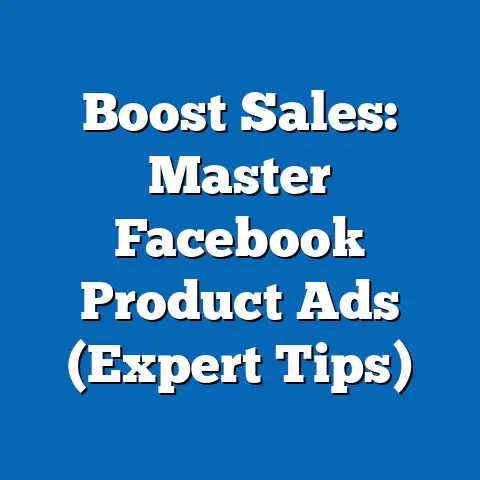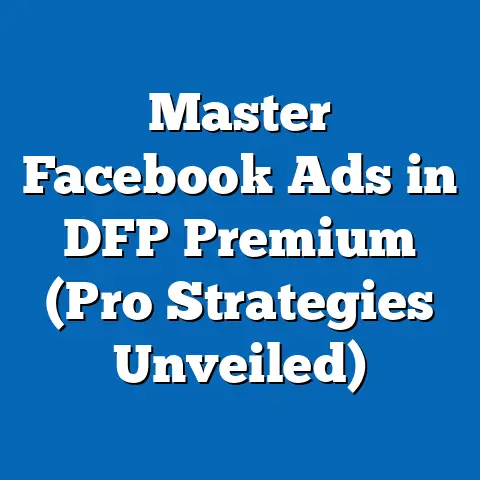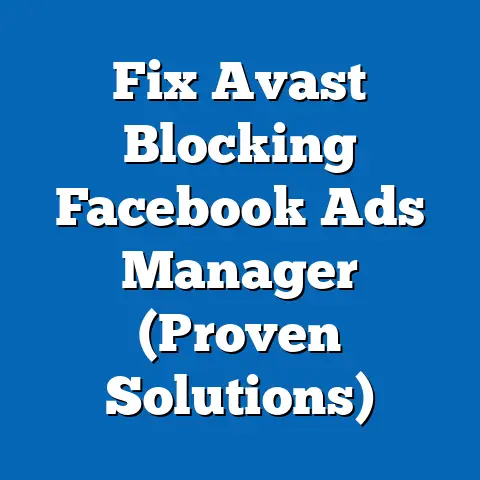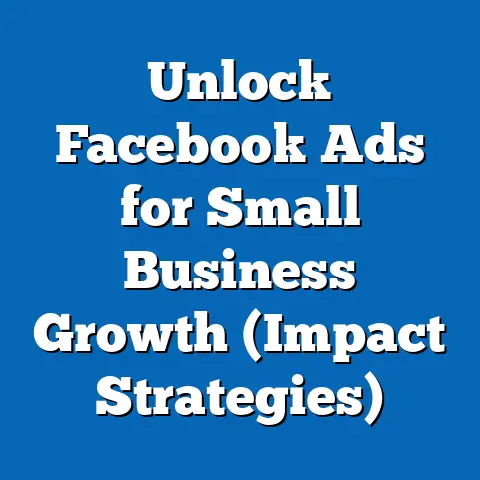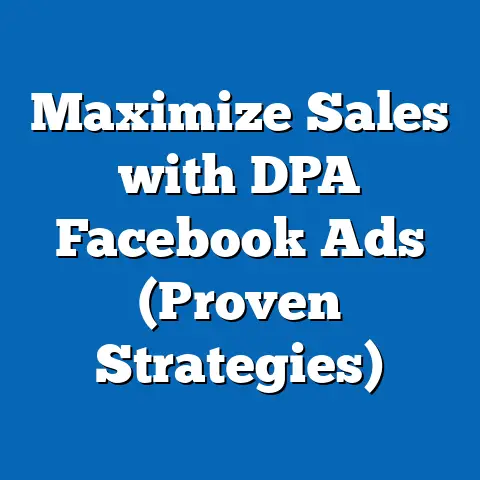Unlocking Facebook Ads: Can They Be PSAs? (Insightful Review)
Facebook. It’s a name synonymous with social connection, but it’s also a powerhouse of advertising. I’ve spent years navigating the ever-changing landscape of Facebook Ads, and I’ve seen firsthand how businesses can leverage its power to reach their target audiences. But what about using this platform for something bigger, something that benefits society? Can Facebook Ads be effectively used as Public Service Announcements (PSAs)?
The answer, in my experience, is a resounding yes. Facebook, with its billions of users and sophisticated targeting capabilities, presents an unprecedented opportunity for PSAs to connect with specific audiences in a way that traditional media simply can’t match. Think about it: instead of hoping your message reaches the right people through a TV spot, you can pinpoint individuals based on their demographics, interests, even their online behavior.
Integrating strategic Facebook advertising into PSA campaigns can amplify their impact, raise awareness about critical issues, and drive tangible community engagement. It’s about moving beyond simply informing people and inspiring them to take action. In this article, I’ll delve into the potential of Facebook Ads as a PSA tool, exploring its capabilities, examining successful case studies, and offering practical guidance on creating impactful campaigns. We’ll also look at the future of this intersection and the ethical considerations that come with it. So, buckle up, because we’re about to unlock the power of Facebook Ads for the greater good.
Section 1: Understanding Facebook Ads
Let’s start with the basics. What exactly are Facebook Ads, and how do they work? In essence, Facebook Ads are paid messages that businesses and organizations can display to users on Facebook, Instagram (which is owned by Meta, Facebook’s parent company), and the Meta Audience Network. These ads appear in various placements, including users’ news feeds, stories, and within Messenger.
The beauty of Facebook Ads lies in their versatility. You’re not limited to a single format or message. I’ve found that experimenting with different ad formats is key to finding what resonates with your audience. Here’s a rundown of some of the most popular options:
- Image Ads: These are the simplest form of Facebook Ads, featuring a single image with accompanying text. They’re great for visually showcasing a product or service, or in the case of PSAs, conveying a powerful message with a striking image.
- Video Ads: Video is king in the digital world, and Facebook Ads are no exception. Video ads can be incredibly engaging, allowing you to tell a story, demonstrate a product, or share a personal message. For PSAs, video can be particularly effective in capturing attention and creating an emotional connection with viewers.
- Carousel Ads: This format allows you to display multiple images or videos in a single ad, which users can scroll through. It’s ideal for showcasing a series of products, highlighting different aspects of a service, or, for PSAs, presenting a multi-faceted message or telling a story in segments.
- Collection Ads: These ads are designed for e-commerce, but the format of showcasing a main video or image with several product images below can be adapted to lead to different information or resources.
- Instant Experience Ads: These full-screen, mobile-optimized experiences open when someone clicks on your ad. They can include videos, images, carousels, and more, offering a highly immersive and engaging way to present your message.
But the real magic of Facebook Ads lies in its targeting capabilities. Unlike traditional advertising, where you’re essentially broadcasting your message to a broad audience and hoping it resonates with someone, Facebook Ads allow you to pinpoint specific individuals based on a wealth of data. You can target users by:
- Demographics: Age, gender, location, education, relationship status, and more.
- Interests: Hobbies, activities, pages they’ve liked, and other interests they’ve expressed on Facebook.
- Behaviors: Purchase history, device usage, travel habits, and other online behaviors.
- Custom Audiences: You can upload your own customer lists or create audiences based on website visitors or app users.
- Lookalike Audiences: Facebook can create audiences that are similar to your existing customers or website visitors.
For PSAs, this level of targeting is a game-changer. Imagine you’re running a campaign to raise awareness about the dangers of drunk driving. With Facebook Ads, you can target young adults in specific geographic areas who have expressed an interest in nightlife or social events. Or perhaps you’re promoting a mental health resource for veterans. You can target veterans based on their demographic information and interests, ensuring your message reaches the people who need it most.
Key Takeaway: Facebook Ads offer a diverse range of ad formats and incredibly precise targeting capabilities, making them a powerful tool for reaching specific audiences with tailored messages. For PSAs, this means the ability to connect with the right people at the right time with the right message, maximizing impact and driving meaningful change.
Section 2: The Importance of PSAs in Today’s Society
Public Service Announcements (PSAs) are the unsung heroes of social change. They’re the quiet voices in the background, constantly reminding us of the important issues that affect our communities and our world. From promoting public health and safety to raising awareness about social injustices and environmental concerns, PSAs play a vital role in shaping public opinion and inspiring positive action.
I’ve always been impressed by the power of a well-crafted PSA. It’s not about selling a product; it’s about selling an idea, a value, a better future. Think about some of the most iconic PSAs of all time:
- “Friends Don’t Let Friends Drive Drunk”: This campaign, launched by the Ad Council in the 1980s, dramatically reduced drunk driving fatalities by promoting a culture of responsibility and peer intervention.
- “A Mind is a Terrible Thing to Waste”: This United Negro College Fund campaign, which has been running for decades, has helped countless students from underserved communities access higher education.
- “Keep America Beautiful”: This campaign, featuring the iconic “Crying Indian” ad, raised awareness about littering and environmental pollution.
These PSAs, and countless others, have made a significant impact on our society. They’ve changed attitudes, influenced behavior, and ultimately, made the world a better place.
But in today’s fragmented media landscape, traditional PSA campaigns face significant challenges. With so many competing voices vying for our attention, it’s becoming increasingly difficult to reach audiences effectively. Television viewership is declining, radio listenership is shifting to streaming services, and print media is struggling to survive.
This is where Facebook Ads come in. By leveraging the platform’s targeting capabilities, PSAs can cut through the noise and reach the people who are most likely to be receptive to their message. They can target specific demographics, interests, and behaviors, ensuring that their message is seen by the right people at the right time.
Furthermore, Facebook Ads offer a level of interactivity and engagement that traditional media simply can’t match. Users can like, comment, and share PSAs, sparking conversations and amplifying their reach. They can also click on links to learn more about the issue or donate to the cause.
Key Takeaway: PSAs are essential for addressing social issues and promoting positive change, but traditional campaigns face challenges in reaching audiences effectively. Facebook Ads offer a powerful solution by providing targeted reach, increased engagement, and measurable results.
Section 3: Case Studies of Successful Facebook Ad PSAs
Now, let’s get into some real-world examples. I’ve scoured the internet and my own network to find compelling case studies of organizations that have successfully used Facebook Ads for their PSA campaigns. These examples demonstrate the power of this platform to raise awareness, drive engagement, and ultimately, make a difference.
Case Study 1: The Trevor Project
The Trevor Project is a non-profit organization that provides crisis intervention and suicide prevention services to LGBTQ young people. They used Facebook Ads to reach LGBTQ youth who might be struggling with their mental health. Their strategy included:
- Targeting: LGBTQ young people based on their interests and demographics.
- Creative Content: Ads featured personal stories from LGBTQ individuals who had overcome challenges and found support.
- Call-to-Action: Ads directed users to The Trevor Project’s website, where they could access resources and connect with counselors.
Results: The Trevor Project saw a significant increase in website traffic and helpline calls after launching their Facebook Ad campaign. They were able to reach LGBTQ youth who might not have otherwise known about their services.
Case Study 2: The American Heart Association
The American Heart Association used Facebook Ads to raise awareness about the importance of CPR training. Their strategy included:
- Targeting: Adults in specific geographic areas who had expressed an interest in health and fitness.
- Creative Content: Ads featured short videos demonstrating CPR techniques.
- Call-to-Action: Ads directed users to the American Heart Association’s website, where they could find CPR training courses.
Results: The American Heart Association saw a significant increase in enrollment in their CPR training courses after launching their Facebook Ad campaign. They were able to reach people who were interested in learning CPR and provide them with the resources they needed to get trained.
Case Study 3: UNICEF
UNICEF has frequently used Facebook Ads to promote their global initiatives, including campaigns to provide clean water, education, and healthcare to children in need.
- Targeting: Facebook users who have demonstrated an interest in humanitarian causes, international affairs, and charitable giving. They also target specific demographics in countries where UNICEF operates.
- Creative Content: The ads often feature compelling images and videos that show the impact of UNICEF’s work on the lives of children. They also include powerful storytelling elements that evoke empathy and inspire action.
- Call-to-Action: The primary call-to-action is to encourage users to donate to UNICEF. The ads often include a direct link to a donation page.
Results: UNICEF’s Facebook Ad campaigns have been highly successful in raising awareness and generating donations.
Key Takeaways: These case studies demonstrate that Facebook Ads can be a powerful tool for PSAs when used strategically. By targeting the right audience, creating compelling content, and including a clear call-to-action, organizations can achieve significant results.
Section 4: Best Practices for Creating Facebook Ad PSAs
So, how do you create a Facebook Ad PSA that actually works? I’ve learned a few things over the years, and I’m happy to share my best practices with you.
- Define Your Target Audience: This is the most critical step. Before you even start creating your ad, you need to know who you’re trying to reach. What are their demographics? What are their interests? What are their behaviors? The more specific you can be, the better.
- Craft a Clear and Concise Message: You have limited time to capture someone’s attention, so make sure your message is clear, concise, and easy to understand. Use simple language and avoid jargon.
- Use Compelling Visuals: People are visual creatures, so make sure your ad includes a high-quality image or video. The visual should be relevant to your message and emotionally engaging.
- Include a Strong Call-to-Action: What do you want people to do after they see your ad? Do you want them to visit your website? Do you want them to donate to your cause? Do you want them to share your ad with their friends? Make sure your call-to-action is clear and prominent.
- A/B Test Your Ads: A/B testing involves creating multiple versions of your ad with slight variations (e.g., different headlines, different images, different call-to-actions) and then testing them against each other to see which one performs best. This is a great way to optimize your ads and improve your results.
- Monitor and Analyze Your Results: Facebook Ads Manager provides a wealth of data about your ad performance. Pay attention to metrics like reach, impressions, engagement, and conversions. Use this data to refine your targeting, adjust your messaging, and optimize your ads for better results.
- Be Authentic and Transparent: People can spot a fake a mile away. Be authentic and transparent in your messaging. Share your story, be honest about your goals, and let people know how they can help.
- Set a Realistic Budget: It’s important to set a budget that aligns with your goals and resources. You don’t need to spend a fortune to see results, but you do need to invest enough to reach a meaningful audience.
- Consider Ad Placements: Facebook offers a variety of ad placements, including the news feed, right column, and Instagram. Experiment with different placements to see which ones work best for your target audience.
- Stay Up-to-Date: Facebook Ads is constantly evolving, so it’s important to stay up-to-date on the latest features and best practices. Follow industry blogs, attend webinars, and experiment with new strategies to stay ahead of the curve.
Key Takeaway: Creating effective Facebook Ad PSAs requires careful planning, creative content, and a data-driven approach. By following these best practices, you can maximize your impact and drive meaningful change.
Section 5: Future Trends and Innovations in Facebook Advertising for PSAs
The world of Facebook advertising is constantly evolving, and the future holds exciting possibilities for PSAs. Here are a few emerging trends and technologies that I believe will have a significant impact:
- AI-Driven Targeting: Artificial intelligence is already playing a role in Facebook Ads, and its influence will only continue to grow. AI can be used to analyze vast amounts of data and identify patterns that humans might miss, allowing for even more precise targeting.
- Augmented Reality (AR) Ads: AR ads overlay digital content onto the real world, creating immersive and interactive experiences. Imagine an AR ad that allows users to virtually try on a helmet before riding a motorcycle, promoting safe driving habits. The possibilities are endless.
- Video Content Dominance: Video continues to be the most engaging format on Facebook, and I expect this trend to continue. PSAs will need to embrace video to capture attention and tell compelling stories.
- Personalized Advertising: Consumers are increasingly demanding personalized experiences, and advertising is no exception. PSAs will need to tailor their messaging to individual users based on their interests, behaviors, and past interactions.
- Ethical Considerations: As Facebook advertising becomes more sophisticated, it’s important to consider the ethical implications. We need to ensure that PSAs are not used to manipulate or exploit vulnerable populations. Transparency and accountability are essential.
Key Takeaway: The future of Facebook advertising for PSAs is bright, with emerging technologies offering exciting possibilities for reaching audiences and driving impact. However, it’s important to consider the ethical implications and ensure that these tools are used responsibly.
Conclusion
In conclusion, Facebook Ads represent a transformative opportunity for public service announcements. I’ve seen firsthand how this platform can amplify the reach and impact of PSAs, connecting them with specific audiences in ways that were never before possible. By leveraging the platform’s targeting capabilities, creating compelling content, and embracing emerging technologies, organizations can drive social change and community engagement on a scale that was previously unimaginable.
However, it’s important to remember that Facebook Ads are just a tool. Like any tool, it can be used for good or for ill. It’s up to us to ensure that it’s used responsibly and ethically, to promote positive change and make the world a better place.
The future of PSAs in the digital advertising landscape is bright. As technology continues to evolve, I believe that Facebook Ads will play an increasingly important role in shaping public opinion, influencing behavior, and inspiring action. It’s time to unlock the power of Facebook Ads for the greater good.

